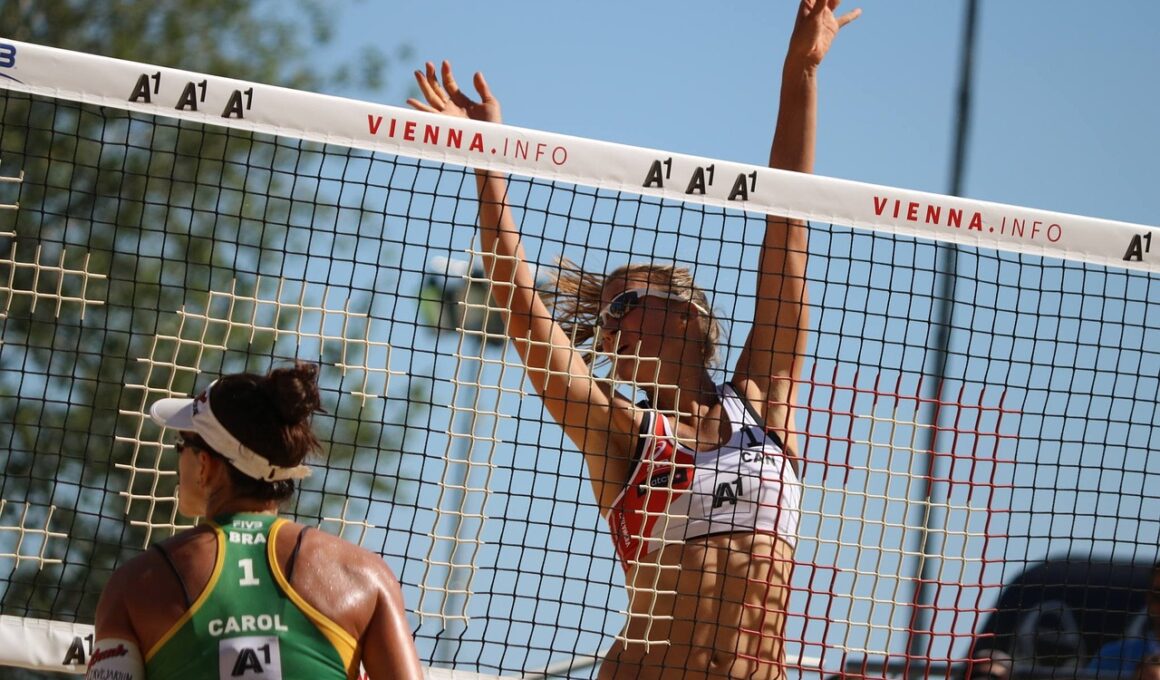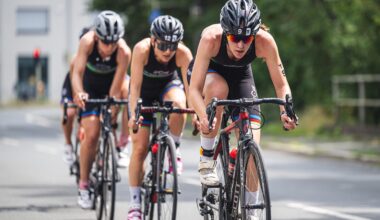The Connection Between Agility and Reaction Time in Volleyball
In volleyball, the ability to move quickly and respond to plays is crucial for success. Reaction time plays a fundamental role in a player’s performance. The faster the player reacts, the better their chances of executing successful plays. This includes not only serving but also spiking, blocking, and receiving. Reaction time is the interval between the perception of a stimulus and the initiation of a response. This lag differs among players and can be improved with specialized training. Coaches emphasize the significance of agility in conjunction with reaction time, as both aspects are interconnected. Developing agility enhances overall movement efficiency, allowing players to position themselves optimally to respond to quick plays. Individualized drills that focus on improving both agility and reaction time are essential, as they cater to each player’s unique needs and skill levels. By integrating specific reaction time drills, players can not only improve their quick decision-making abilities but also practice executing their skills efficiently under pressure. This combination often results in improved overall performance during matches and practice alike, which is critical for any player wishing to excel on the court.
Furthermore, agility training focuses on enhancing coordination, balance, and speed. Coaches typically use obstacle courses and agility ladders to increase foot speed and quickness in various directions. This type of conditioning directly affects a player’s reaction time, as enhanced body control allows them to perform quick movements with greater precision. Players can benefit from a variety of agility exercises, which can be adapted based on their specific roles within the team. For example, setters may require different drills than outside hitters. Drills like lateral hops and shuttle runs can significantly impact a player’s court coverage. Understanding the link between agility drills and improved reaction time enables coaches to develop better training programs. These tailored routines can improve both individual and team performance, making players more competitive during games. Awareness and adaptability are essential factors in volleyball since each game scenario is unpredictable. Hence, improving reaction time through agility training translates effectively into real match situations. Both on-court awareness and physical conditioning allow volleyball players to better anticipate opponents’ movements, thus improving their responses to various plays, which is essential for gameplay effectiveness.
Incorporating technology, such as reaction time apps and tools, offers players real-time feedback on their performance. Such innovations allow players to track progress in agility and reaction improvements. For instance, devices that capture movement and reaction speeds provide valuable data to both players and coaches. Coaches can utilize this data to assess strengths and weaknesses in each player’s game, helping them to tailor specific training regimens that focus on needed improvements. Video analysis can also serve as a powerful tool in understanding how agility and reaction time affect performance on the court. Reviewing game footage enables athletes to visualize their body movements and subsequent reactions during various match scenarios. By identifying patterns, athletes can adjust their training methods to enhance their responsiveness. These insights are integral in honing a player’s overall strategic approach during practices and games. Furthermore, consistent training, combined with the feedback received from these tools, leads to progressive improvements, and athletes can monitor their development over time. Committing to a routine that emphasizes agility and reinforced reaction time will yield positive outcomes on and off the court.
Nutrition also plays a vital role in enhancing agility and reaction time in volleyball. Proper nutrition fuels the body, ensuring it operates at peak performance levels. Players require a balanced diet rich in carbohydrates, proteins, and healthy fats to sustain energy during training and matches. Foods rich in antioxidants can help reduce inflammation and improve recovery times after strenuous workouts, which is crucial for continuous training progress. Supplements that promote mental focus and cognitive function can also be beneficial, as enhanced mental clarity directly correlates with quicker reaction times. Keeping hydrated is equally important; dehydration can lead to decreased physical performance and slower cognitive functions. Therefore, structured meal plans that align with training schedules can significantly influence athletic performance. Within these plans, athletes should include plenty of hydration and nutrient-rich foods. Coaches must emphasize education on nutrition to their players to support overall agility and reaction time improvement, especially during intense training phases and competitive seasons. Shifting the focus towards comprehensive development routines integrates physical training and nutritional awareness, which ultimately fosters athletes’ performance on the court.
Recovery Techniques for Improving Agility and Reaction Time
Recovery techniques play a critical role in an athlete’s ability to maintain high performance in volleyball. Incorporating rest days in training schedules ensures players recharge physically and mentally. Equally important are techniques such as stretching, foam rolling, and massage therapy. These methods not only aid in muscle recovery but aid in improving flexibility, which is beneficial in enhancing agility. Regular practices of these recovery techniques can directly relate to quicker reactions during gameplay, as players are less likely to experience stiffness and limitations in movement. Recovery practices should also include adequate sleep, as it is essential for muscle repair and mental sharpness. Lack of sleep can lead to slower reaction times, reducing a player’s effectiveness on the court. Employing a comprehensive recovery regimen, including hydration and balanced nutrition, ensures that athletes maintain optimal physical states. It’s through this combined approach that volleyball players can effectively minimize injuries and boost performance levels. Furthermore, education on the importance of recovery should be an essential part of training programs to foster a successful culture around maintaining fitness and ensuring long-term athletic development.
Moreover, practicing mindfulness and mental training exercises can significantly benefit volleyball players in reaction time. Focused visualization techniques allow players to mentally rehearse various game situations, strengthening their cognitive response. Mental drills can improve awareness of surroundings and decision-making abilities on-court. During stressful situations in matches, being calm and mentally prepared can lead to quicker reactions. Teaching players breathing exercises and mindfulness techniques can help develop mental fortitude, which complements physical training. When players feel grounded mentally, they’re less prone to make rushed decisions that might impair their reaction timing. Establishing routines that incorporate these mental exercises into regular training can enhance how well players handle game pressure. Additionally, engaging in team-building activities strengthens players’ connections, fostering trust in teammates. This enhances communication, reduces reaction times to anticipated plays, and builds synergy on the court. Engaging the mind alongside physical training ultimately leads to comprehensive development, establishing a balanced athlete prepared for competitive challenges they will face in matches.
Lastly, integrating competitive simulations into training helps volleyball players improve their combined agility and reaction time under pressure. Simulated game scenarios present players with experiences that closely resemble actual game situations. By introducing competitive elements during drills, players train their ability to make quick judgment calls effectively. These simulations allow players to practice reactions in real-time, which promotes better timing on the court. Coaches can design drills that incorporate sudden changes in direction or unexpected plays, creating situations that require immediate responses. This enhances both reaction speed and agility, mirroring the unpredictable nature of actual games. During these sessions, athletes can also receive immediate feedback from coaches, aiding in identifying key areas needing improvement. This responsive training approach creates a dynamic learning environment. Building these competitive skills through rigorous practice will lead to noticeable improvements in reaction time and overall court performance. Consequently, players who consistently engage in realistic practices will have a distinct advantage during actual games, leading to better outcomes as they outpace opponents in agility and quickness.
In conclusion, the synergy between agility and reaction time fosters success in volleyball training. This dual focus enhances individual and group performances on the court, creating a more competitive atmosphere. Hence, volleyball training programs should prioritize the development of both agility and reaction time through tailored drills, technological feedback, nutrition, and mental preparedness. Programs that include diverse training components yield better-equipped athletes. By honing both physical and mental attributes, players can better respond to dynamic match environments. Skilled athletes exhibit quick decision-making capabilities when confronted with immediate challenges, showcasing both agility and response time. Such integrated training strategies not only improve competitive performance but also empower players to thrive in various on-court scenarios. Therefore, encapsulating these principles in training programs can lead to remarkable benefits for volleyball athletes. Coaches and players must embrace a well-rounded approach to develop agility and speed for peak performance. Ultimately, focusing on agility and reaction time is essential to achieving excellence in volleyball. The pursuit of these skills contributes to overall sports performance, fostering athlete growth and optimizing competitive readiness as they face challenges throughout their careers.


